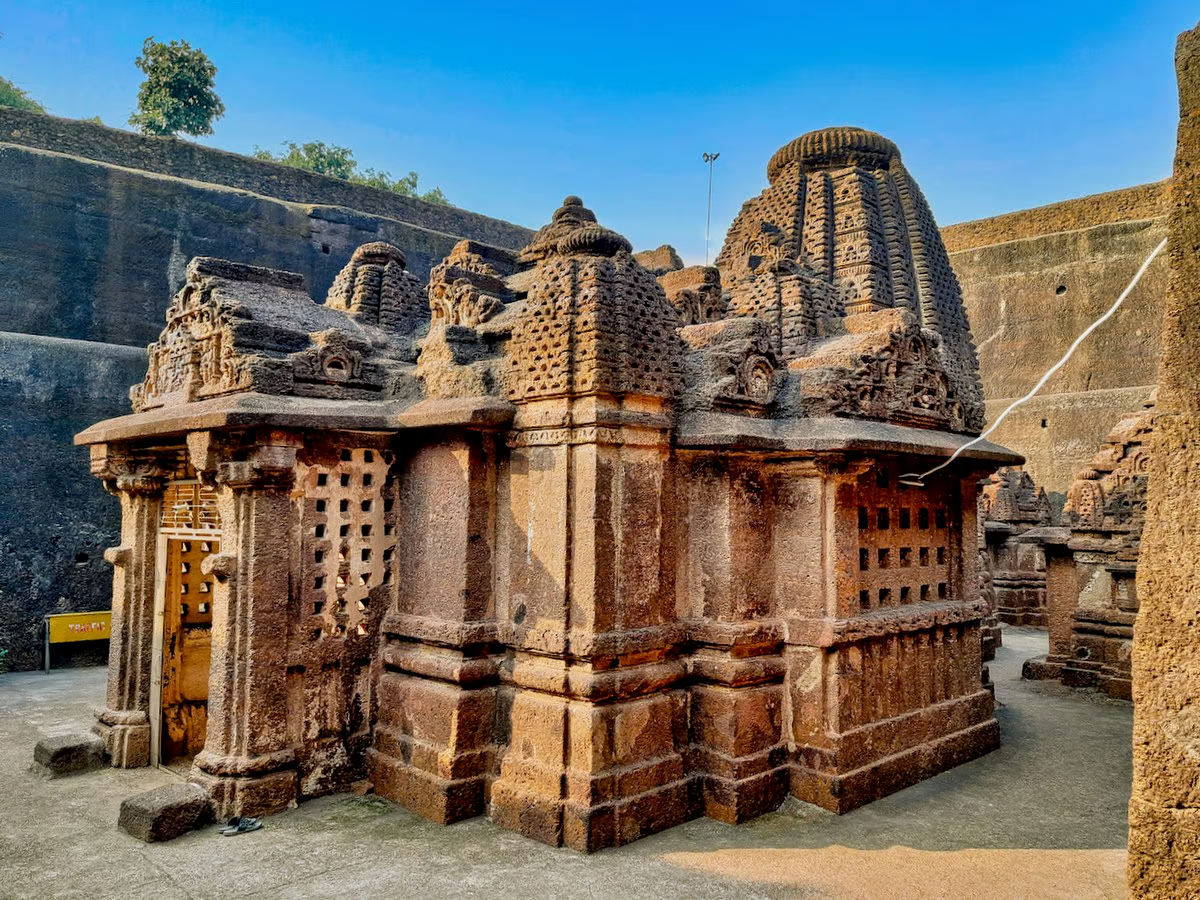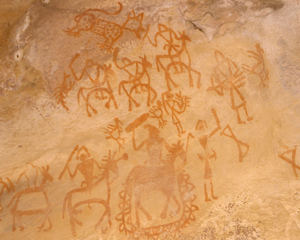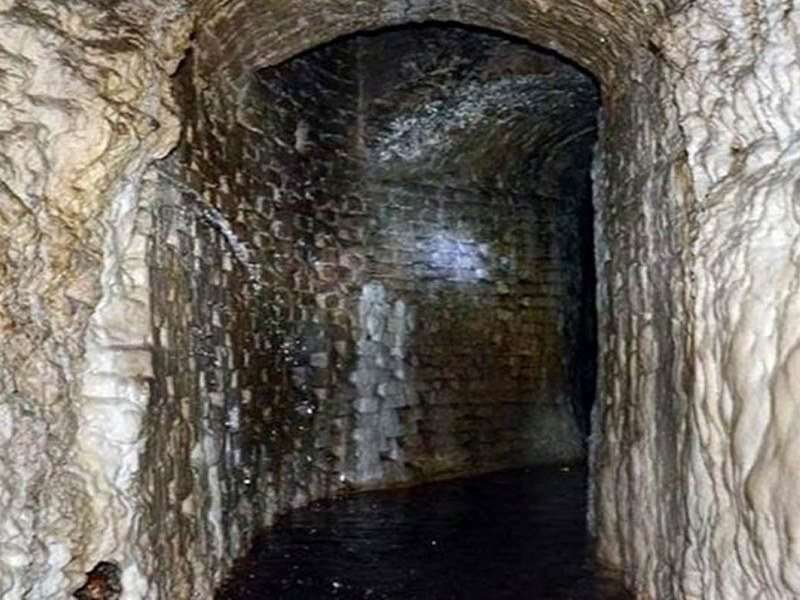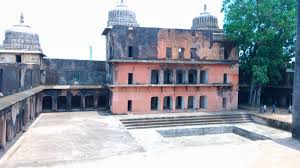Indian Heritage & Culture
6 New Sites from MP Listed on UNESCO's Tentative World Heritage Sites List
- 01 Apr 2024
- 10 min read
For Prelims: Gwalior Fort, Historical Group of Dhamnar, Bhojeshwar Mahadev Temple, Rock Art Sites of Chambal Valley, Khooni Bhandara, Burhanpur, and Gond monuments of Ramnagar, Mandla, United Nations Educational, Scientific and Cultural Organization, India’s World Heritage Sites.
For Mains: Key Features of SItes Recently Added to Tentative UNESCO List of WHS, Types of Heritage Sites.
Why in News?
Recently, 6 new sites from Madhya Pradesh have found place in the Tentative UNESCO list of World Heritage Sites (WHS).
- The sites included in the new list included Gwalior Fort, Historical Group of Dhamnar Bhojeshwar Mahadev Temple, Rock Art Sites of Chambal Valley, Khooni Bhandara, Burhanpur, and Gond monuments of Ramnagar, Mandla.
What are the Key Features of Sites Recently Added to Tentative UNESCO List of WHS?
- Gwalior Fort: It is renowned for its formidable walls, stands atop a hill providing panoramic views of the surrounding city.
- Historically, it is believed that the fort's first foundations were laid in the 6th century AD by Rajput warrior Suraj Sen.
- Suraj Sen was the local chieftain who suffered from a severe leprosy but was healed by a hermit-saint named Gwalipa. In gratitude for this event, he established the Gwalior City named after him.
- The Gwalior fort witnessed a tumultuous history of invasions and reconstructions, notably under the Tomar ruler Maan Singh in 1398, who added several monuments to its premises.
- After Mansingh Tomar's reign, Gwalior came under Ibrahim Lodi, then the Mughal Sultanate. Akbar regained control in 1550 CE. The Marathas, led by the Scindias, took over later.
- The fort briefly fell to General White during the second Maratha War but returned to Scindia control in 1805 CE until 1857.
- British rule lasted until 1886 CE when it was exchanged for Jhansi and returned to the Scindias.
- The fort boasts several ancient temples, including the Teli ka Mandir dedicated to Shiva, Vishnu, and Matrikas.
- The Chaturbhuj temple is notable for its mathematical significance, featuring one of the oldest references to zero in mathematics.
- The Sas Bahu temples, with the larger one dedicated to Vishnu, date back to 1150 CE and are known for their intricate inscriptions.
- Additionally, the Gurdwara Data Bandi Chhor commemorates Guru Hargobind Sahib, the sixth Sikh guru.
- As per its strategic location on the basalt rock hills, it is mentioned as Gopachala, Gopagiri in the old Sanskrit inscriptions.
- Historically, it is believed that the fort's first foundations were laid in the 6th century AD by Rajput warrior Suraj Sen.
- Historical Group of Dhamnar: It comprises 51 rock-cut caves, stupas, chaityas, and dwellings dating back to the 7th century AD.
- Among these, the colossal statue of Gautam Buddha in the nirvana pose is a significant highlight.
- Noteworthy caves include the Bari Kacheri and Bhima Bazar on the northern bank, known for their historical importance and architectural features.
- The earliest accounts of these monuments come from James Tod, who visited in 1821, followed by James Fergusson in 1845 and Alexander Cunningham between 1864-1865.
- The name Dhamnar has no historical or literary basis, but evidence suggests it was known as Chandananagari-mahavihara in Buddhist times.
- Scholar K.C. Jain suggested that 'Dhamnar' may come from the Shaivite term 'Dharmanatha,' associated with the Linga in the mediaeval Vaishnava temple.
- Bhojeshwar Mahadev Temple: It is dedicated to Lord Shiva and boasts a massive Linga carved from a single stone.
- Commissioned by Raja Bhoj in the 11th century, this temple is revered for its grandeur and unique architecture.
- Raja Bhoj was a celebrated ruler of the Paramara dynasty known for his architectural treatise of the Samaranganasutradhara.
- The temple's architecture follows the Bhumija style characterised by its towering shikhara and ornate carvings and sculptures.
- Also, the main body of the temple and its shikhara have components influenced by the Dravidian style of temple architecture.
- Commissioned by Raja Bhoj in the 11th century, this temple is revered for its grandeur and unique architecture.
- Rock Art Sites of the Chambal Valley: It hosts the world's largest concentration of rock art sites, showcasing scenes from various historical periods and civilizations.
- These sites, spanning across Madhya Pradesh, Rajasthan, and Uttar Pradesh, provide insights into ancient human life and cultural evolution.
- The rock art in the basin includes depictions of hunting and gathering scenes created by Mesolithic hunter-gatherers and those from the Protohistoric and later periods.
- They flourish in the hilly regions of Vindhyan, Satpura, and Kaimur ranges, marked by parallel ridges and dense vegetation.
- Major rock art sites in the Chambal Basin include Bhimlat Mahadev, Chatturbhuj Nath Nala, Garadia Mahadev, Bukki Mata, Chattaneshwar, and Kanyadeh.
- These sites, spanning across Madhya Pradesh, Rajasthan, and Uttar Pradesh, provide insights into ancient human life and cultural evolution.
- Burhanpur's Khooni Bhandara: It is an underground water management system comprising eight waterworks built by Abdurrahim Khankhana in the historical city of Burhanpur.
- It was built using the Persian qanat approach and designed by Persian geologist, Tabkutul Arz
- During the Mughal era, technologies like Persian Qanats from Iran and Iraq were imported to India as useful public utilities.
- In the early 1900s, 8 sets of these underground conduits were excavated and traced, with 6 of them remaining intact to this day.
- The hint of red colour in this mineral rich water, gave it the name khooni (bloody).
- It was built using the Persian qanat approach and designed by Persian geologist, Tabkutul Arz
- Gond Memorial of Ramnagar, Mandla: The region formerly known as the Central Provinces of India and covering parts of the present-day states of Madhya Pradesh, Chhattisgarh and Maharashtra; was historically called Gondwana, the home of the largest heterogenous tribe of India, the Gond tribe.
- The cluster of monuments include the following:
- Moti Mahal
- Raibhagat ki Kothi
- Suraj Mandir (Vishnu Mandir)
- Begum Mahal
- Dalbadal Mahal
- The cluster of monuments include the following:
Note
3 sites from Madhya Pradesh are already included in UNESCO's World Heritage Sites. These include The Khajuraho Group of Monuments (1986), Buddhist Monuments of Sanchi (1989), and The Rock Shelters of Bhimbetka (2003).
What is the Tentative UNESCO list of World Heritage Sites?
- World Heritage Sites: World Heritage Sites are special places around the world that are considered to be of outstanding value to humanity.
- They are designated by the United Nations Educational, Scientific and Cultural Organization (UNESCO) and are given special protection to ensure they are preserved for future generations.
- It is backed by the international agreement known as the Convention concerning the Protection of the World Cultural and Natural Heritage, established by UNESCO in 1972.
- Tentative UNESCO list of World Heritage Sites: It is a list of sites identified by individual countries (States Parties) that they consider to have "outstanding universal value" and may be suitable for inscription on the World Heritage List.
- It is published by the World Heritage Centre.
- Types of Heritage Sites: There are three types of sites: Cultural, Natural, and Mixed.
- Cultural heritage includes artifacts, monuments, a group of buildings and sites, and museums that have a diversity of values including symbolic, historic, artistic, aesthetic, ethnological or anthropological, scientific and social significance.
- Natural heritage sites are limited to exceptional natural areas with outstanding ecological and evolutionary processes, unique natural phenomena, habitats hosting rare or endangered species, etc.
- Mixed heritage sites incorporate aspects of both natural and cultural significance, blending elements such as historic buildings or archaeological sites with exceptional natural features or ecological processes.
- India’s WHS: India currently has 42 UNESCO World Heritage Sites. The most recent ones include:
- 41st: Santiniketan, established by Nobel laureate Rabindranath Tagore in West Bengal.
- 42nd: The Sacred Ensembles of the Hoysalas in Karnataka, which encompass a group of exquisite Hoysala era temples.
UPSC Civil Services Examination, Previous Year Questions (PYQs)
Q1. Which one of the following statements is correct? (2021)
(a) Ajanta Caves lie in the gorge of Waghora river.
(b) Sanchi Stupa lies in the gorge of Chambal river.
(c) Pandu-lena Cave Shrines lie in the gorge of Narmada river.
(d) Amaravati Stupa lies in the gorge of Godavari river.
Ans: (a)











